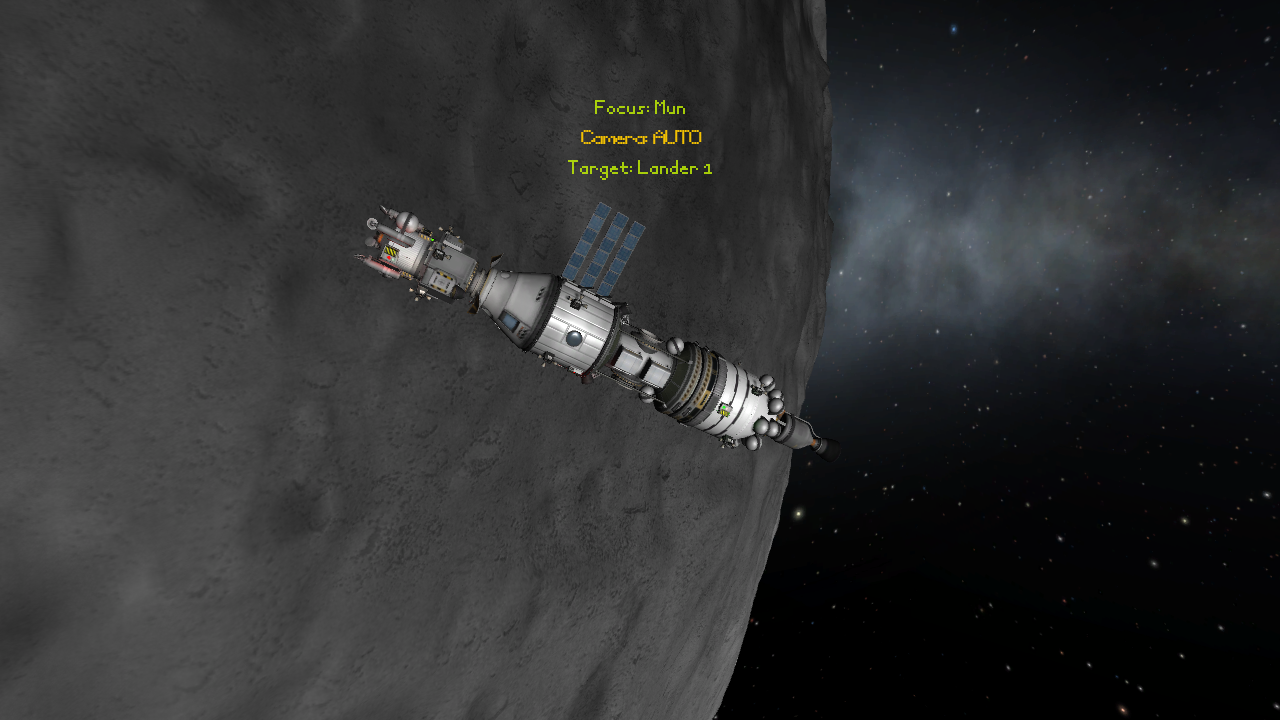I docked the explorer, reloaded all of her full tanks and double-checked all systems to make sure they were what I needed them to be. Then... I launched for Mun.
 |
| Second time out, and the sight was still dramatic as hell! |
 |
| The exit burn from Kerbin orbit. |
The first realization that this wasn't going to go according to "the plan" was when the exit burn to get out of Kerbin orbit took longer than expected. I didn't skimp on fuel, but I did but a full quarter of my supply just getting on my way. I could have aborted, but I decided that it was worth it to keep going, and that my ultimate goal was still within reach.
 |
| Burning Retrograde (slowing down) as I enter Mun orbit. |
The Landing
While the Explorer did come with two lander, the mission was always to land one, and then the second if needed or if it looked promising. I detached the first lander, and put it into a 20K orbit with a landing zone in the middle of a clear field. Watching the decent was nerve wracking. Right when the engines started burning was when I realized that my math was horribly off. I had expected to land with 2/3rds of my take still full, but rather, I landed with less than half, there was no way the lander would be able to launch and meet up with the Explorer.
Right when the engines started burning was when I realized that my math was horribly off. I had expected to land with 2/3rds of my take still full, but rather, I landed with less than half, there was no way the lander would be able to launch and meet up with the Explorer.Still, with the lander on the ground, I did do the moon walk and plant a flag to mark the event.
Then... I had to get back home!
I knew I could get the lander into orbit (barely), and use the RCS thrusters to do fine tuning. After that, it would be up to the explorer to close the distance so the lander could dock.
 |
| KSS explorer in its ad hoc configuration. |
It was over 4 hours (game time, 2 hours real time) of maneuvering before I saw the landed from the Explorer. Even still, it was another hour of waiting before it was close enough for me to chance docking without eating all of the RCS propellant on the lander's two tanks. It took another (very real world) half an hour before the lander closed in for the final docking maneuver.
 |
| Heading home... finally! |
Once I had the Lander finally docked, I moved the second lander back into its position, and then dumped its hyperbolic propellants into the Explorer's tanks for added capacity. At this point, I would need all the help I could get.
The final burn home was like watching a hangman's noose tighten as the ship ent through its fuel supply. For a minute I thought I wouldn't make it, but when it finally completed the last burn into Kerbin orbit, I knew I could at least be able to get the crew home.
But... fortune was with me, I had enough left to actually dock with the Station.
 |
| Final orbital burn.... "Mir" in the distance. |
Final lessons:
The explorer was a proof of concept, and the concept worked. I could make a ship in segments, fly it into orbit, and assemble it there. Using the station as a staging point was a good idea. The use of two landing craft was also proven as solid, and doable, even in a pinch.
Drawbacks:
Fuel
The first major shortcoming was the fuel capacity. The bottom line is that I estimated the fuel usage too tightly, and almost stranded a crew and ship for it. The first thing I will need to do with the next design is to triple the fuel capacity outright.Thrust
The atomic engine worked as planned, but the ship was drastically under-powered. In the future, I am going to need to build with two or three engines, possible even a quad assembly, with a massive fuel load if I am expecting to make true interplanetary trips.
Landers
The Landers worked... but only barely. Any followup trips will have to use larder fuel tanks, possibly with detachable cans in order to save weight on the exit launch. These were never going to be "the" landers, the gravity involved on true planetary landings after this will mean I need to start using larger and power powerful landers. Needless to say, I'll have to incorporate those into the design of the next ship.
The fate of the KSS Explorer:
 |
| KSS Explorer right after the Mun mission |
I never intended the Explorer to be "the" ship for interplanetary travel, and even now with its weakness clearly demonstrated, I have no intent of simply discarding the ship. Rather, I launched a new section, and added a space lab to the main hull. The Ship is now an orbital research station, and maybe I can use it for orbital research of Mun, Luna and perhaps other planets.
 |
| KSS explorer right before the final re-docking after having a Lab added to the hull. |
Trust me on two things.
1. You will see more of the Explorer, she's a good ship, and she's more than able to do a lot for my space exploration program.
2. There will be another ship, and she will build on the lessons learned here.
Until Next time.



No comments:
Post a Comment